Text

The benefits of using intermediaries or recruitment agencies to source international candidates.
Using intermediaries or recruitment agencies to source international candidates can be a valuable resource for companies looking to expand their workforce.
Here are some of the benefits of using these services:
Wider reach: Recruitment agencies have access to a wider pool of candidates than a company may be able to reach on its own. This can be especially helpful when looking for international candidates, as it can be difficult to identify top talent in other countries without local connections.
Expertise: Recruitment agencies specialize in finding candidates for specific industries and roles. They have the knowledge and experience to identify the best candidates and match them with the right companies.
Time and cost savings: Sourcing international candidates can be a time-consuming and costly process. Using a recruitment agency can free up your company's time and resources, as the agency handles much of the legwork.
Cultural fit: Recruitment agencies can help ensure that the candidates they present are a good fit for your company culture. They can also provide support and guidance to help candidates adjust to their new environment.
Compliance: Working with a recruitment agency can also help ensure compliance with local laws and regulations regarding hiring international workers. The agency can handle the necessary paperwork and ensure that everything is in order.
Overall, using intermediaries or recruitment agencies to source international candidates can provide a number of benefits to your company. These services can help you find top talent, save time and resources, and ensure compliance with local laws and regulations.
Ready to take your company global?
Let Global Workforce Recruitment help! Our team of experienced recruiters specializes in finding top international talent in a variety of industries.
From identifying the right candidates to providing comprehensive support throughout the hiring process, we have the expertise and resources to help your company succeed in the global job market.
Contact us today to learn more and get started on building your dream team!
Connect with us at [email protected]
Explore our Global Workforce Recruitment Services for 45+ Industries
#globalworkforce#recruitment#internationaljobs#globalcareers#multilingualjobs#diversityandinclusion#remotejobs#globalrecruitment#workforceplanning#employeebenefits#talentacquisition#jobsearch#hiring#employees#workforcemanagement
0 notes
Text

Tips for negotiating favorable terms and prices with international suppliers
Negotiating favorable terms and prices with international suppliers can be a challenging task, but by following certain tips, you can increase your chances of securing a good deal.
Here are some tips for negotiating with international suppliers:
Research the market: It's important to have a good understanding of the market and the prices that other suppliers are offering. This will help you negotiate from a position of strength and ensure you are getting a fair price.
Know your needs: Before entering into negotiations, have a clear understanding of your needs and what you are willing to compromise on. This will help you focus on the most important terms and prices during negotiations.
Be prepared to negotiate: Don't be afraid to negotiate and be willing to walk away from a deal if the terms and prices are not favorable. It's important to remember that you are in control of the negotiation and have the power to say no.
Use your leverage: If you are a large buyer or have a long-term relationship with the supplier, you may have more leverage in negotiations. Use this to your advantage and don't be afraid to use it to negotiate better terms and prices.
Consider alternative options: If negotiations with one supplier are not going well, consider exploring options with other suppliers. This can help you get a better understanding of the market and may lead to better terms and prices.
By following these tips, you can increase your chances of negotiating favorable terms and prices with international suppliers. It's important to be prepared, know your needs, and use your leverage to secure the best deal possible.
Attention all business owners!
Are you tired of wasting time and resources on the procurement process?
Look no further than Industrial Procurement Services! Our team of experts will handle all of your procurement needs, freeing up your time to focus on what matters most - running your business.
Don't miss out on this opportunity to streamline your operations and increase efficiency.
Contact Industrial Procurement Services today to learn more!
Connect with us at [email protected]
Explore our Industrial Procurement Services for 30+ Industries
#industrialprocurement#procurementpros#supplychainmanagement#efficiencyexpert#streamliningsolutions#businessbooster#industryinnovator#sourcingexcellence#procuringsuccess#supplychainsimplified
0 notes
Text

The role of education and training in preparing for a globalised workforce
The role of education and training in preparing for a globalised workforce is crucial in today's increasingly interconnected world. With the rapid advancement of technology and the increasing interdependence of economies, it is more important than ever for individuals to be well-educated and trained in order to succeed in the global marketplace.
There are several ways in which education and training can help individuals prepare for a globalised workforce:
Developing language skills: In a globalised world, it is important for individuals to be able to communicate with people from different countries and cultures. By learning a foreign language, individuals can expand their communication skills and increase their employability in a globalised workforce.
Gaining cultural awareness and understanding: In a globalised world, it is important for individuals to have a deep understanding of different cultures and customs in order to work effectively with people from around the world. Education and training programs that focus on cultural awareness and understanding can help individuals better navigate and succeed in a globalised workforce.
Learning technical skills: With the increasing reliance on technology in the globalised workforce, it is important for individuals to have a strong foundation in technical skills such as computer programming, data analysis, and problem-solving. Education and training programs that focus on these skills can help individuals stay competitive in a globalised workforce.
Building a global network: In a globalised workforce, having a strong network of professional connections can be crucial for career advancement. Education and training programs that provide opportunities for networking and building relationships with professionals from around the world can help individuals establish a strong foundation for success in a globalised workforce.
Overall, education and training play a vital role in preparing individuals for a globalised workforce. By developing language skills, cultural awareness, technical skills, and a global network, individuals can increase their employability and succeed in today's interconnected world.
Are you a business looking to expand your operations on a global scale?
Our company provides global workforce solutions for industries of all kinds. From finding top talent to managing international payroll and employee benefits, we have the resources and expertise to help your business succeed on a global level.
Contact us today to learn more about how we can support your global expansion.
Connect with us at: [email protected]
Explore Talent'd Services: https://www.talentd.worldref.co/
#globalworkforce#industries#internationalbusiness#talentmanagement#workforcesolutions#industryspecificsolutions#internationaltalentmanagement#globalhr#crossculturalteams#globalpayroll#internationalbenefits#globalexpansion#globalbusiness
0 notes
Text

The impact of globalisation and industrialisation on developing countries
The impact of globalisation and industrialisation on developing countries has been a topic of much debate and discussion in recent years. On one hand, these forces have brought many benefits to developing countries, including increased economic growth, expanded trade and investment opportunities, and access to new technologies and ideas. However, on the other hand, globalisation and industrialisation have also brought challenges and negative consequences for many developing countries. In this blog, we'll take a closer look at the impact of globalisation and industrialisation on developing countries, exploring both the positive and negative aspects of these phenomena.
Positive impacts of globalisation and industrialisation on developing countries:
Economic growth: One of the most significant positive impacts of globalisation and industrialisation on developing countries is economic growth. By opening up markets and increasing trade and investment, these forces can drive economic development and improve living standards in developing countries.
Access to new technologies and ideas: Globalisation and industrialisation have also brought new technologies and ideas to developing countries, helping to improve productivity and efficiency. This can lead to the development of new industries and businesses, and can also help to improve the quality of life for people in these countries.
Increased employment opportunities: As globalisation and industrialisation drive economic development in developing countries, they can also create new employment opportunities. This can be especially important in countries with high levels of poverty and unemployment.
Improved infrastructure: Globalisation and industrialisation can also lead to the development of improved infrastructure in developing countries, including roads, ports, and telecommunications systems. This can help to facilitate economic growth and make it easier for businesses and individuals to connect with one another.
Negative impacts of globalisation and industrialisation on developing countries:
Income inequality: While globalisation and industrialisation can bring economic growth and increased employment opportunities to developing countries, they can also lead to growing income inequality. In many cases, the benefits of globalisation and industrialisation accrue disproportionately to those at the top of the income ladder, while those at the bottom may see little improvement in their standard of living.
Environmental degradation: The increased production and consumption associated with globalisation and industrialisation can also lead to environmental degradation in developing countries. This can include air and water pollution, deforestation, and other negative impacts on natural resources.
Cultural homogenisation: Globalisation and industrialisation can also lead to the erosion of local cultures and traditions in developing countries, as people are exposed to new ideas and ways of life. This can lead to a sense of loss of identity and a feeling of being left behind.
Dependency on external markets: Finally, globalisation and industrialisation can also create dependency on external markets in developing countries. This can leave these countries vulnerable to economic shocks and downturns, and can make it difficult for them to develop their own domestic industries and businesses.
In conclusion, the impact of globalisation and industrialisation on developing countries is complex and multifaceted. While these forces can bring many benefits, they also bring challenges and negative consequences that must be carefully considered and addressed in order to ensure that globalisation and industrialisation serve the needs and interests of all people.
Ready to take your business global?
Our globalisation and industrialisation services can help!
From market research and strategy development to supply chain management and logistics, we have the expertise and resources to help your business succeed in a global market.
Contact us today to learn more and start expanding your reach!
Connect with us at [email protected]
Explore our services to expand your business globally: https://worldref.co/services/
Explore industries we serve: https://worldref.co/industries/
#globalisation#industrialisation#developingcountries#economy#globalbusiness#internationaltrade#globalmarket#globalization#globaleconomy#globalreach#globalcitizenship#incomeinequality#poverty#socialjustice#economicdevelopment
1 note
·
View note
Text
Which Countries are the Top Ten Export Destinations of India, 2021?

India’s largest destination for its exports is the United States, which accounts for over 18.05% of Indian exports. The top commodities are diamonds and pharmaceuticals.
The UAE stands as the 2nd largest destination for Indian exports, accounting for over 6.65% of Indian exports. The main commodities of export to the UAE are diamonds and pharmaceuticals.
Other major export destinations are China (5.04%), Bangladesh (3.83%), Netherlands (2.97%), Singapore (2.64%), Hong Kong (2.60%), UK (2.48%), Germany (2.34%), and Nepal (2.29%).
Which Countries are the major sources of Indian imports in 2021?

In terms of commodities imported, China stands as India’s biggest source of imports, averaging approximately $94.5 billion in 2022, with a share of over 15.43% in Indian imports during the same time frame, and a growth percentage of 45.02% from 2020-2022.
The UAE stands as the 2nd largest source of Indian imports, with an average import value of approximately $44.83 billion in 2021. Its share of Indian imports is well over 7.31%. The main commodities of import are mineral fuels and diamonds.
Other major partners of India in terms of imports are the USA (7.07%), Saudi Arabia (5.56%), Iraq 5.21%), Switzerland (3.82%), Hong Kong (3.12%), Singapore (3.09%), Korea (2.85%), and Germany (2.44%).
Read more @ International Trade Profile of India
#indian trade#international trade#indian economy#indian exports#indian imports#Indian Import sources#Indian Export sources#global trade
0 notes
Text
Which Countries have Trade Deficit with India, in 2021?

According to Ministry of Commerce data, India’s trade deficit with China widened in 2021-22 and will continue to do so in 2022-23. India’s trade deficit with China rose to $73.31 billion in 2021-22 from $44.02 billion in 2020-21.
Iraq ($29.52), Saudi Arabia ($25.34), Switzerland ($22.04), UAE ($16.78), Qatar ($11.35), Kuwait ($9.75), South Korea ($9.39), Indonesia ($9.23), and Australia ($8.47) are the next highest in terms of trade deficit.
Read more @ International Trade Profile of India
#indian trade#indian imports#global trade#international trade#indian exports#trade surplus#Trade deficit
0 notes
Text
Which Countries have Trade Surplus with India in 2021?
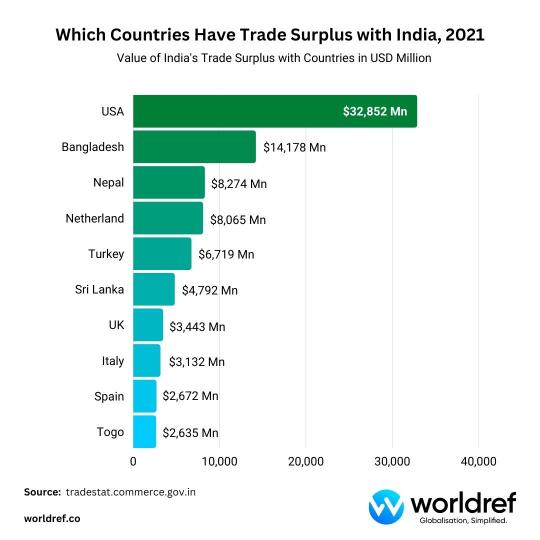
The Ministry of Commerce and Industry of India announced that the United States will be India’s biggest trading partner in 2021-22, overtaking China. The United States outperforms all others in terms of its trade balance with India, with a trade surplus of $32.85 billion.
Bangladesh ($14.17 billion) stands 2nd in terms of trade surplus and was followed by Nepal ($8.27 billion), the Netherlands ($8.06), Turkey ($6.71 billion), Sri Lanka ($4.79), the UK ($3.44), Italy ($3.13 billion), Spain ($2.67 billion) and Togo ($2.63 billion).
Read more @ International Trade profile of India
0 notes
Text
What can be the Import opportunities by India?
Retail is one of the fastest-growing business sectors in India. According to Forrester Research, the retail sector in India was worth $883 billion in 2020 and is predicted to expand to $1.3 trillion by 2024.
The income from e-commerce in India is predicted to increase from $46.2 billion in 2020 to $136.47 billion by 2026. With significant investment in technology and infrastructure, as well as a rapidly expanding number of internet users, India is predicted to become the world’s fastest-growing e-commerce industry.
Click here to read more International Trade Profile of India
#international trade#global trade#indian economy#international data#worldref insights#salesdevelopment#salesopportunityinIndia
0 notes
Text
What are the Export Opportunities from India?
The Indian economy is booming and on a growth trajectory that no other global economy can match. India offers an excellent combination of a flourishing domestic market potential, highly trained labour, and an increasingly open regulatory framework. All of this makes India a popular location for multinational corporations wishing to grow their footprint and achieve long-term commercial success.
The reasons why India is the next significant target market for global corporations are Domestic Market Opportunity, Growing Technology Infrastructure, Human Capital, and Open Regulatory Environment.
Know more @ International Trade Profile of India
#international trade#global trade#indian economy#Business Opportunities in India#Purchasing Opportunity in India#Global Business#indian imports#indian exports#Indian Employment
0 notes
Text
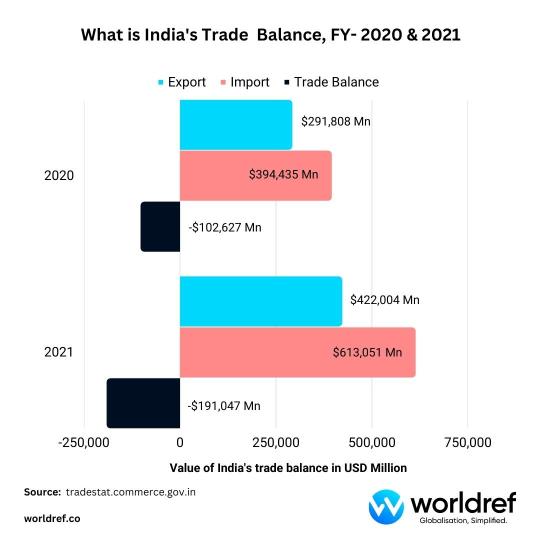
What is India's Trade Balance in FY-2020-21
India imports and exports a wide range of goods and services, and it is a key trading partner for many nations, including the United States, China, the United Arab Emirates, Saudi Arabia, Iraq, Singapore, Hong Kong, Indonesia, Korea, and Australia. Together, these countries account for about 98.76% of Indian trade.
The Ministry of Commerce and Industry of India announced that the United States will be India’s biggest trading partner in 2021-22, overtaking China. The United States outperforms all others in terms of its trade balance with India, with a trade surplus of $32.85 billion.
According to Ministry of Commerce data, India’s trade deficit with China widened in 2021-22 and will continue to do so in 2022-23. India’s trade deficit with China rose to $73.31 billion in 2021-22 from $44.02 billion in 2020-21.
Read more @ International Trade Profile of India
#indian trade#general news#India Trade Balance#international trade#indian economy#Indian Export#Indian Imports
0 notes
Text
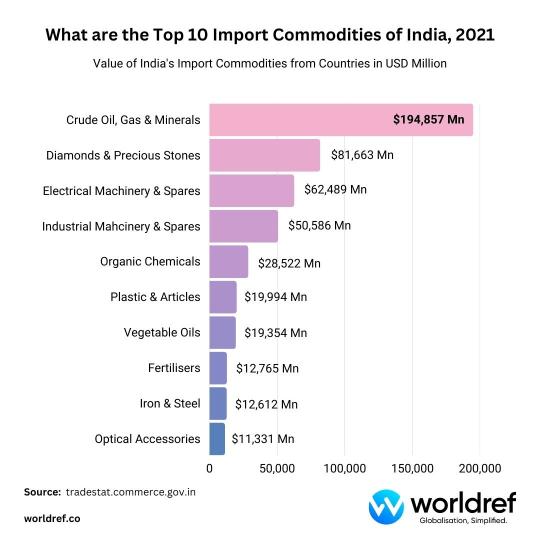
These are the most important imports into India contributing to the Indian economy. Major Commodities of Indian Import in the year 2021-22 were Crude Oil, Gas & Minerals ($19.4 billion), Diamonds & Precious Stones ($81.67 billion), Electrical Machinery & Spares ($62.48 billion), Industrial Machinery & Spares ($50.59 billion), Organic Chemicals ($28.53 billion), Plastic & Articles ($19.99 billion), Vegetable Oils ($19.36 billion), Fertilisers ($12.76 billion), Iron & Steel ($12.61 billion), and Optical Accessories ($11.34 billion).
Read more @InternationalTradeProfileofIndia
#indian economy#indian imports#international trade#global trade#international data#worldref insights#Global business#trade profile#international trade profile
0 notes
Text
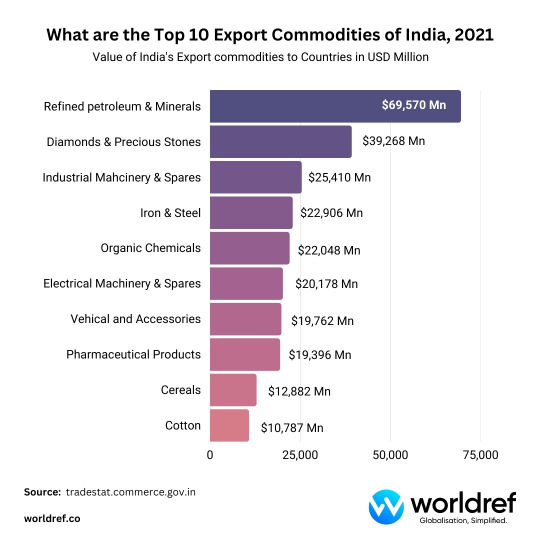
In terms of value, India’s top export commodities in 2021-22 are Refined petroleum ($69.57 billion), Diamonds & Precious Stones ($39.26 billion), Industrial Machinery & Spares ($25.41 billion), Iron & Steel ($22.90 billion), Organic Chemicals ($22.04 billion), Electrical Machinery & Spares ($20.17 billion), Vehicle and Accessories ($19.76 billion), Pharmaceutical Products ($19.39 billion), Cereals ($12.88 billion), Cotton ($10.78 billion).
These significant exports account for 62.13% of India’s total export income. This shows that India exports a variety of products. Indian services are also very highly regarded in the service sector.
Read more @ International Trade Profile of India
#indian economy#indian exports#indian trade#trade commodities#Indian Export Commodities#Indian Business#International Trade Profile
0 notes
Text
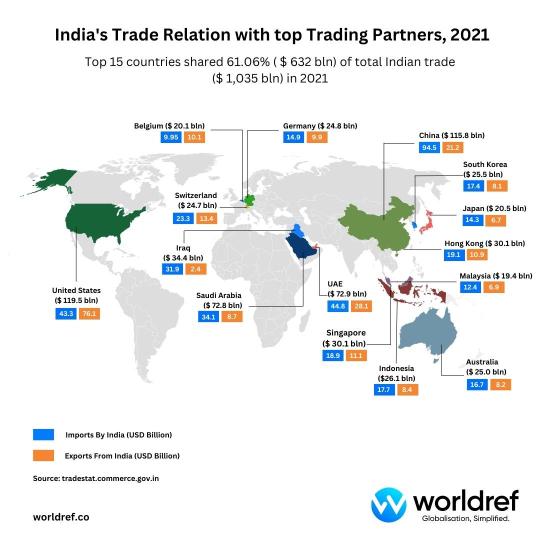
Top Trading Partners of India
Even though India isn’t yet a major export hub, contributing just 1.8% of the $21.513 trillion in global exports in 2021. But, its export growth is evident by the growth in exports, clocking US$ 394.8 billion in commodity exports, a 33.4% rise over 2017 and a 43.3% increase from 2020.
India’s largest destination for its exports is the United States, which accounts for over 18.05% of Indian exports. The top commodities are diamonds and pharmaceuticals.
Regarding imported commodities, China stands as India’s biggest source of imports, averaging approximately $94.5 billion in 2022, with a share of over 15.43% in Indian imports during the same time frame, and a growth percentage of 45.02% from 2020-2022.
Click here to read more
#indian trade data#indian trade#indian imports#indian exports#global trade#international trade#international data#Indian trade profile#International Trade Profile India
0 notes
Text

India's GDP Growth rate 2022
According to the United Nations Conference on Trade and Development (UNCTAD), India’s Gross Domestic Product (GDP) increased by 8.7% in FY22, making it one of the fastest-growing economies in the world.
India’s growing economy attracts foreign investment and is a lucrative destination for foreign investors and startups. According to OECD estimates, India’s GDP increased by 0.8% in the 1st quarter of 2022 over the previous quarter.
Click here to read more
0 notes
Text

Starting a new business isn’t as simple as coming up with an idea.
In addition to the time investment needed to formulate and create a business, there’s often a hefty capital requirement. A new business usually requires paying different fees for licensing, permits, and approvals, and many governments also have minimum on-hand capital requirements.
And costs are relative. Though it might be more costly to start a business in some countries on paper, affordability also takes into account relative income.
Which Country is the Cheapest for Starting a Business: https://lnkd.in/d5dcJfM
#business#startup#financial#investment#enterpreneur#starting a business#globalisation simplified#international trade#globalization
2 notes
·
View notes
Text
The use of biofuels helps reduce human greenhouse gas emissions. That’s one reason why some petroleum companies offer petrol containing up to 10% ethanol (a biofuel). But if we are to have any real chance of avoiding catastrophic climate change, it is not enough to reduce our emissions; we must put the process into reverse.
We must aim for “negative emissions”. This means removing carbon dioxide from the atmosphere and ideally returning to pre-industrial atmospheric CO₂ levels. This is a daunting task: the present atmospheric concentration is 410 parts per million (ppm), compared with around 280ppm before the Industrial Revolution.
Andrew Hopkins of Australian National University writes on how recent breakthrough research in biofuels has brought human mankind closer to realizing the dream of achieving “negative carbon emissions”.
Read here: https://worldref.co/w-insights/biofuel-breakthroughs-bring-negative-emissions-a-step-closer/
1 note
·
View note
